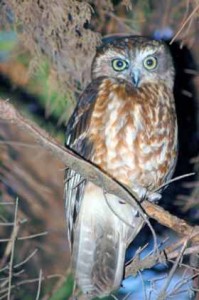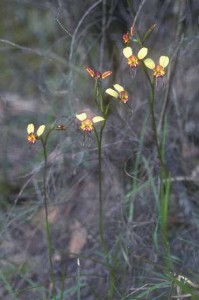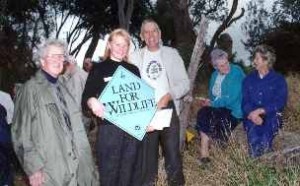You are here: Recreation » Nature Reserves » Flora and Fauna
The Kananook reserves are a delightful and rewarding destination for bird watchers and naturalists.
Flora
Over 200 indigenous species can be found in the reserves. Trees include Coast Banksia, Tea-tree, Coast Wattle, Swamp Paperbark, Black Wattle, Drooping She-Oak, Manna Gum. Sweet Bursaria, Beard Heath, Goodenia, and Correa are representative of the smaller shrubs.
Climbers and groundcovers Clematis, Pigface and Running Postman twist and scramble for space. Grasses include Kangaroo, Wallaby Grass and Poa. A variety of rushes and sedges can be found. Numerous wildflowers, orchids, and lilies are resplendent during the spring months.
The KCA Flora Listing contains a more comprehensive listing of plants and their status in the reserves. Tables include plants propagated for planting in the reserves and weeds targeted for removal.
If you are able to provide updated information or corrections to flora and fauna listings, please don’t hesitate to contact us.
Kananook Creek Flora and Fauna Report FCC 2020
Kananook Creek Flora and Fauna Report, FCC, June 2020 was compiled for the Kananook Creek Arboretum Project.
Frankston Vegetation Study 2006
Frankston City Council, Ecology Australia 2006
Frankston Vegetation Study (2006) prepared by Ecology Australia notes that the Coast Banksia Woodland has a conservation status of Vulnerable, and Swamp Scrub, a conservation status of Endangered.
Fauna
Kananook Creek and its environments support a variety of local native plants and plant communities and these in turn, provide valuable habitat for our native birds, mammals, fish, aquatic creatures, reptiles, frogs, and insects.
The KCA Fauna Listing indicates fauna documented in the Kananook reserves. The KCA would delighted to hear from anyone who can verify sightings or add to the list.

Left – Boobook Owl Below – Land For Wildlife Accreditation
Land for Wildlife
In 1996, the Kananook reserves were designated Land for Wildlife.
Land for Wildlife (LfW) is a voluntary, non-binding property registration scheme which encourages and assists landholders to provide habitats for wildlife on their property.
Wildlife habitat can:
• contribute to plant and animal biodiversity
• provide links between isolated remnants allowing wildlife movement and genetic interchange.
Recreation » Nature Reserves «« Previous Page| Next Page »» Recreation » Nature Reserves » Walking Trails


